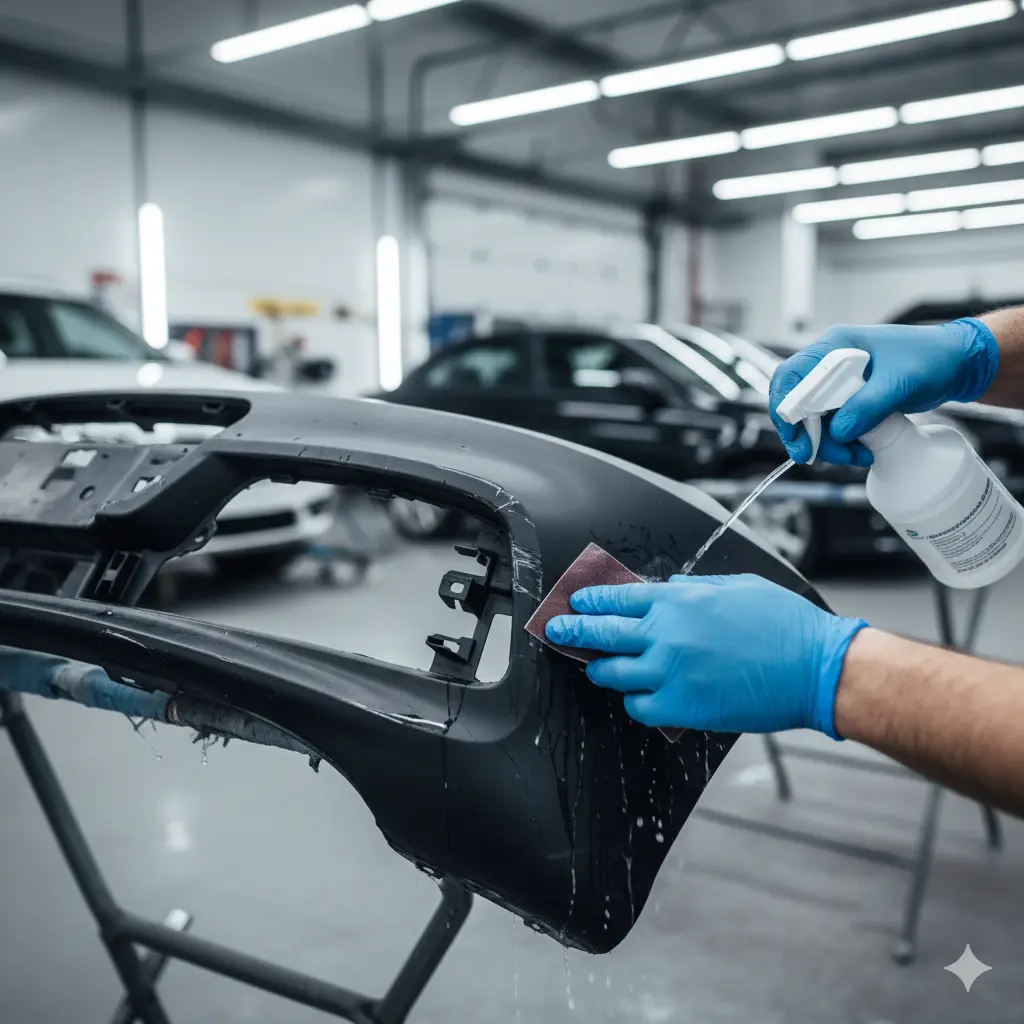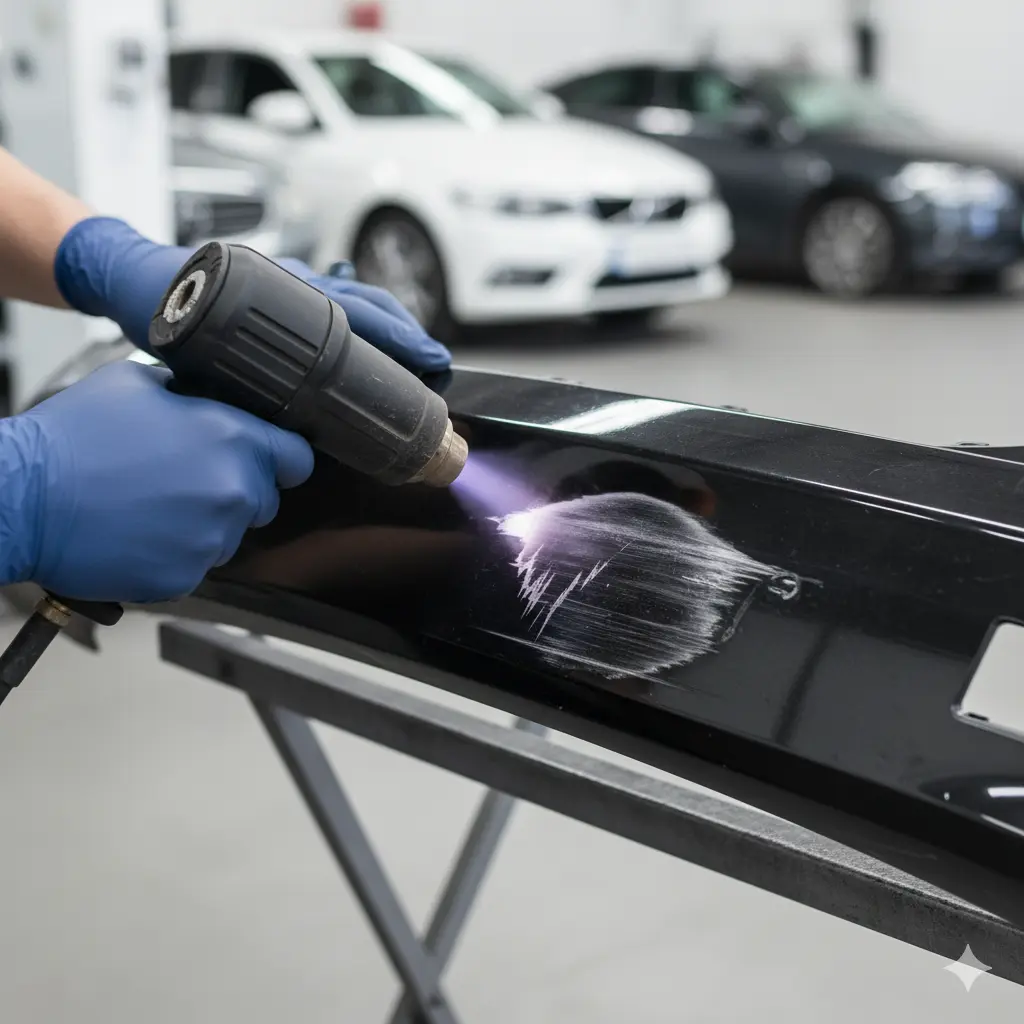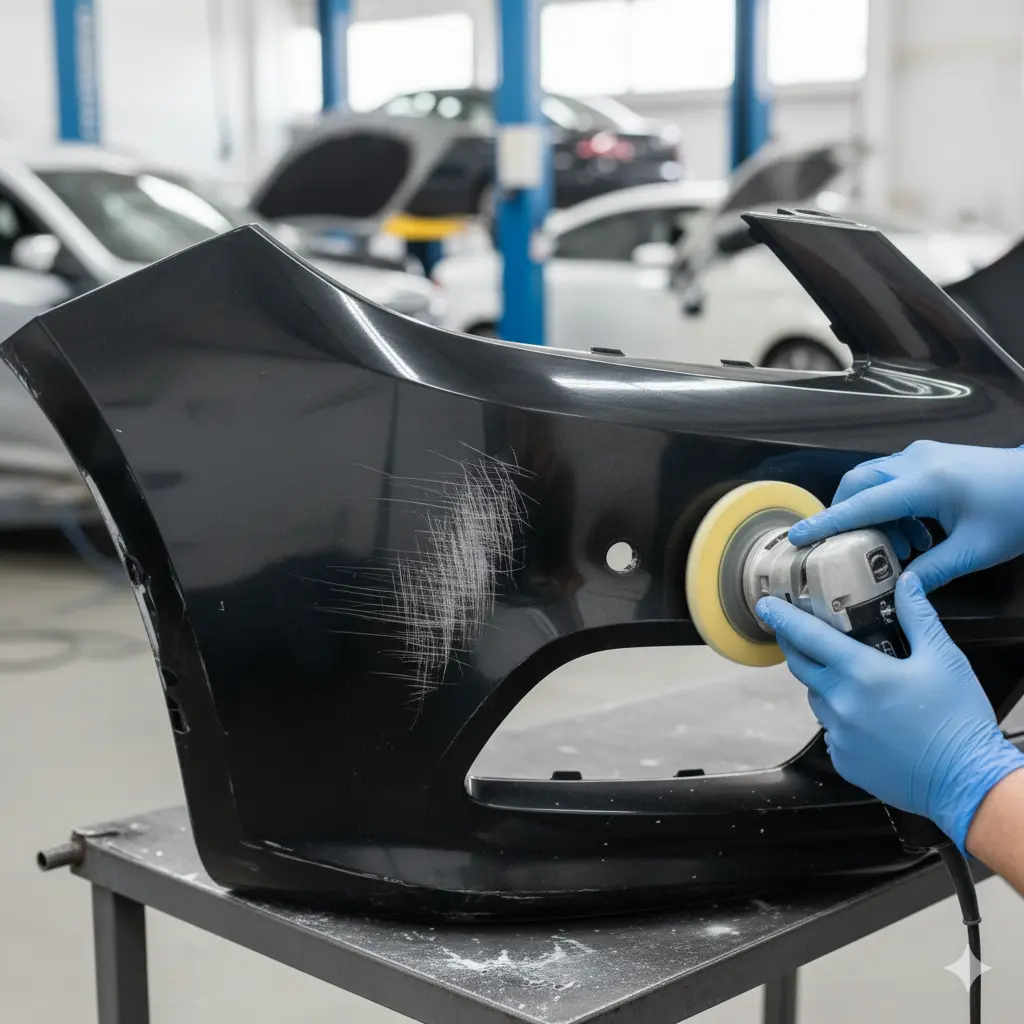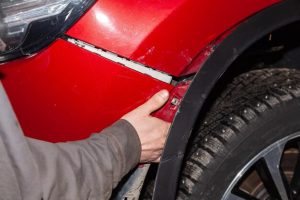Black plastic bumper scratch repair is necessary when a scratch damages the sleek, dark finish of your black plastic bumper. But before you get into the very acceptable habit of looking up the cost of a full replacement, stop and take a deep breath. Most of these blemishes are probably more repairable than you think. This guide aims to prepare you with what you need to know about how to fix black plastic bumper scratches, including the reason for scratches and when to leave it to the professionals, and the cost involved.
What Causes Scratches on Black Plastic Bumpers?
The black plastic located on your exterior car, especially the bumpers, is manufactured to be durable and flexible. It’s intended to endure some punishment without breaking or shattering. Still, it’s not invincible. Black plastic bumper scratch repair is needed if one of the following happens:
- Parking Lot Blunders: A car door opened too wide, a shopping cart went rogue, or just a tight parallel park effort can make for a hefty mark.
- Road Debris: Small rocks, gravel, or other debris that cars kick up generally leave small and noticeable scuffs on your bumper.
- Bumpers (Fender Benders): Even low-speed fender benders, however trivial, will lead to gouges or scrapes.
- Automatic Car Washes: In certain automatic car washes, the stiff brushes of old will take time to create fine swirl marks and scratches.
Understanding the cause of the scratch also comes with the black plastic bumper scratch repair. A light scuff of a fingernail or a minor scratch is less severe than the deep groove or scratches from a curb, respectively.
Tools and Materials You’ll Need for Scratch Repair
Searching for how to remove scratches from car bumper at home? If you are going to work on the black plastic bumper scratch repair yourself, you’ll need to gather a few items. Most of these items can be easily found in an auto parts store or online.
- Microfiber cloths: You’ll need several, preferably soft ones. These are soft compared to paper towels, so they won’t add extra scratches.
- Automotive soap or cleaner: Use something specifically designed for cars, rather than a car soap or dish soap.
- Rubbing alcohol (optional): This is great for a final, no-residue cleaning.
- Automotive masking tape: This will be used to protect any surrounding paint.
- Fine-grit sandpaper (1500-2500 grit): You may need this to level off deeper scratches.
- Car plastic scratch remover, or polish: Just remember, you want something specifically for plastic/car trim.
- Heat gun or hairdryer (optional): This is an option for “melting” away very light scratches on textured plastic. Be extra careful when using this method for black plastic bumper scratch repair.
- Plastic restorer/protectant: This will finish the job and protect for future wear.

Step-by-Step Black Plastic Bumper Scratch Repair
Are you ready to get your hands dirty? Here’s a comprehensive guide on how to remove scratches from black plastic car exterior.
Step 1: Clean the Scratched Area
This might be the most crucial step. A dirty surface causes more scratches. Use your soap made specifically for use on vehicles and water to fully clean the bumper. Clean the entire bumper, especially the scratched area before starting the black plastic bumper scratch repair. You want to ensure that all dirt, grime, and wax are removed. Once you’ve washed the bumper, dry it completely with a clean microfiber towel. You can finish off with a quick wipe of rubbing alcohol to ensure there is complete cleanliness – you want a very clean surface for the next steps.
Step 2: Assess the Scratch Depth
Rub your fingernail over the scratch. If your nail catches in the groove, then it’s a deep scratch. If you can’t feel your nail at all, then it’s a light surface scuff. This very simple test will determine what repair method you will work with next. Light scuffs can be polished out rather easily, how to fix deep scratches on plastic bumper will require much more effort.
Step 3: Fixing Light Scratches with Polish or Restorer
For less severe, shallow scratches, you will usually just need a plastic scratch remover. Simply apply a small amount of that product to a clean microfiber cloth to start your black plastic bumper scratch repair. Using a circular motion and medium pressure, rub the product into the scratched area. Your goal here is to fill in the tiny grooves and smooth the surface. You will want to wipe excess product away and have a look at what you have done. You may need to repeat this a few times to achieve the look you want.
Step 4: Sanding or Heating for Deeper Scratches
Now for the part where the real work begins for how to fix deep scratches on plastic bumper.
- Sanding: For scratchs that are too deep for polishing, you will need to sand. Using very fine-grit sandpaper (1500 or 2000 grit), lightly sand the scratch. Use a small amount of water to keep the area lubricated (this is called “wet sanding). Sand in the direction of the scratch to smooth out the edges for your black plastic bumper scratch repair. At this point, don’t try to remove the scratch completely; instead, you just want to smooth out the surrounding plastic to minimize the appearance. Once the scratched plastic is leveled, jump to a higher grit (2500) to smooth out the sanding.
- Heating (Use with Great Care): On textured, unpainted black plastic, applying heated air directly to the scratch while using a heat gun or a hairdryer at the highest heat setting may sometimes “heal” a light to moderate scratch. The heat causes the plastic to melt slightly and then reform; thus, closing the scratch. Hold the heated air about 6-8 inches away from the scratch and keep moving the heat source. Do not linger in one spot or melt the plastic, making the problem much worse. This method is risky; only attempt the repair method on unpainted, textured plastic, and use it only for minor scratches.
Step 5: Buff and Protect for a Lasting Finish
Regardless of whether you polished or sanded the black plastic bumper scratch repair, it is important to finish the job properly. A clean microfiber cloth should be used to buff the area to a shine. Then, use a dedicated plastic restorer or protectant. This final step will rehydrate the plastic, return the deep black color to the plastic, and provide protection against UV and more scratches. This also makes repairs look professional and last much longer.
DIY vs Professional Scratch Repair: Which Is Better?
Now it’s time for you to decide after reading through these steps.
Pros and Cons of DIY Fixes
Pros:
- Cost savings: Doing the yourself is always less expensive. It will cost you a few tools and a black plastic bumper scratch repair kit.
- Convenience: It’s your schedule and your garage. You can do this too.
- Satisfaction: There’s a certain satisfaction that comes with fixing something that you did.
Cons:
- Skill: Patience, care and skill will be needed to produce a professional-looking finish. You can also make the problem worse if you don’t know what you are doing.
- Time: What may seem like a 30-minute job can easily take you an afternoon!
- Not for every type of damage: DIY repairs and fixes should be done with scuffs and light scratches. It is not a miracle remedy for deep cracks, major gouges, or torn plastic.

When to Call a Professional
When you have a large scrape, a fracture on the bumper, or you’re not confident enough to try black plastic bumper scratch repair, then it’s time to call in a professional. A professional plastic bumper repair specialist will have the equipment, experience and expertise to work with any level of damage. If you are looking for an elite bumper repair in Houston, a reputable shop like Westside Collision can inspect the damage properly, recommend an appropriate solution, and have your car looking new. Professionals will be able to use advanced techniques like plastic welding to paint and finish the bumper making the scrape go away like it never happened.
How Much Does Black Plastic Bumper Scratch Repair Cost?
The black plastic bumper scratch repair cost can range quite significantly, depending on how you choose to have it repaired.
DIY Repair Kit Costs
Each decent plastic scrape remover kit or plastic scrape repair kit you find will cost from about $15-$50. Sandpaper, cloths, and other miscellaneous materials are inexpensive. Most repairs can be generally accomplished for about $75, depending on how complex the repair is.
Professional Repair Pricing
Professional work will range from $150 for very small repairs to $500 for deeper repairs. Getting an estimate from a reputable shop such as Westside Collision is the best way to get an accurate estimate. However, if you are looking for cheap bumper repair near me, make sure you check reviews and ensure their credibility.
Best Products for Black Plastic Bumper Scratch Repair
The market is full of products. Here are several categories to consider:
- Best Scratch Removers: These products are generally liquid or cream polishes that are intended to fill in and polish out light scratches. Meguiar’s, TFor a light scuff, you can just polish it. For a deep gouge, you are looking at a multi-step solution that may include sanding, filling, and possibly a heat gun. If you have a lot of damage, it may be best to consult professionals for your bumper repair in Houston.urtle Wax, and 3M carry some good options.
- Plastic Restorers and Protectants: These products won’t repair scratches, but they are an essential step in the process. They restore vibrant black color and protect from UV damage. Chemical Guys and Mothers have some excellent options.
- All-in-One Repair Kits: These kits have everything you would need (sandpaper, polish, etc.) and are great beginner options.
How to Prevent Future Scratches on a Black Plastic Bumper
It’s best to prevent scratches than to have to fix them. Here are some simple tips to help avoid black plastic bumper scratch repair:
- Be Careful When Parking: Leave extra space by parking away from shopping cart returns and at the ends of rows.
- Use a Protectant: A true plastic protectant or ceramic coating is a better option. These products provide a sacrificial coating that can help repel minor scuffs.
- Hand-wash your Vehicle: Avoid using stiff brushes and automatic car washes, as they can scratch the finish.
Conclusion: Restore Your Black Plastic Bumper Like New
A scratch on your black plastic bumper is annoying, but it doesn’t have to be an eyesore for the life of your vehicle. If you know how to do it, you can restore your car’s exterior to its original condition. Depending on your comfort level, you can either repair the black plastic bumper scratch yourself using a good plastic scratch remover, or you can have a professional assist with more serious types of damage.
If you’re looking for bumper repair Houston and want to ensure it’s done right, Westside Collision is the place to go. Our qualified technicians will take care of anything from a minor scuff to major damage, and your car will leave looking like a brand new vehicle! Don’t let a scratch diminish the appearance of your car; restore your ride!
FAQ
Can toothpaste really fix bumper scratches?
Some swear it works, but toothpaste is an abrasive and certainly not made for auto plastic. All it will do is create additional micro scratches and a cloudy residue. Use a proper car plastic scratch repair product.
Does WD-40 remove scratches?
No, WD-40 is a lubricant, not a scratch remover. It may temporarily ‘hide’ a light scratch because it can fill it, but it evaporates, allowing the scratch to return, so it is not a permanent solution.
How do I handle deep gouges vs light scuffs?
For a light scuff, you can just polish it. For a deep gouge, you are looking at a multi-step solution that may include sanding, filling, and possibly a heat gun. If you have a lot of damage, it may be best to consult professionals for your bumper repair in Houston.





